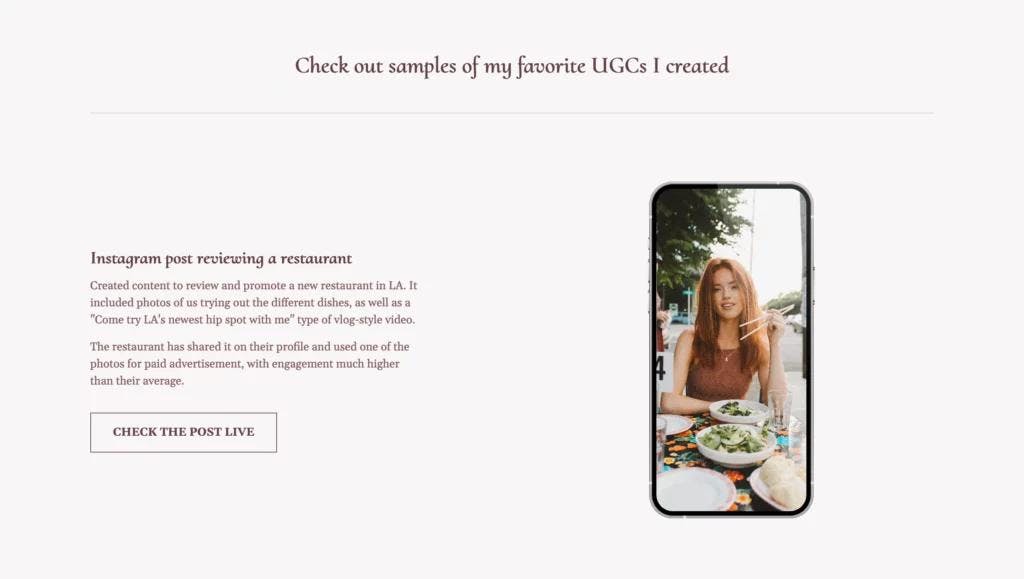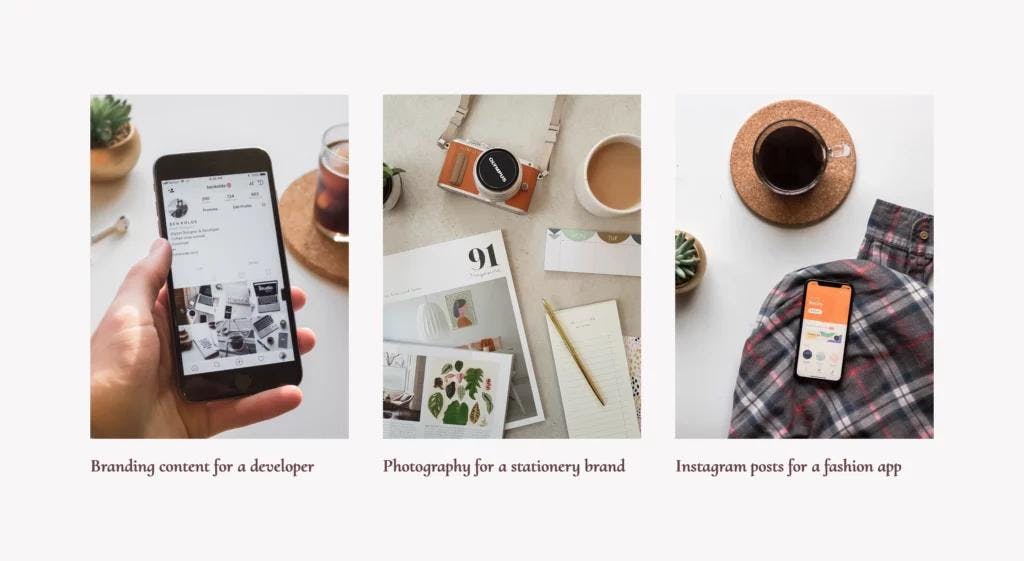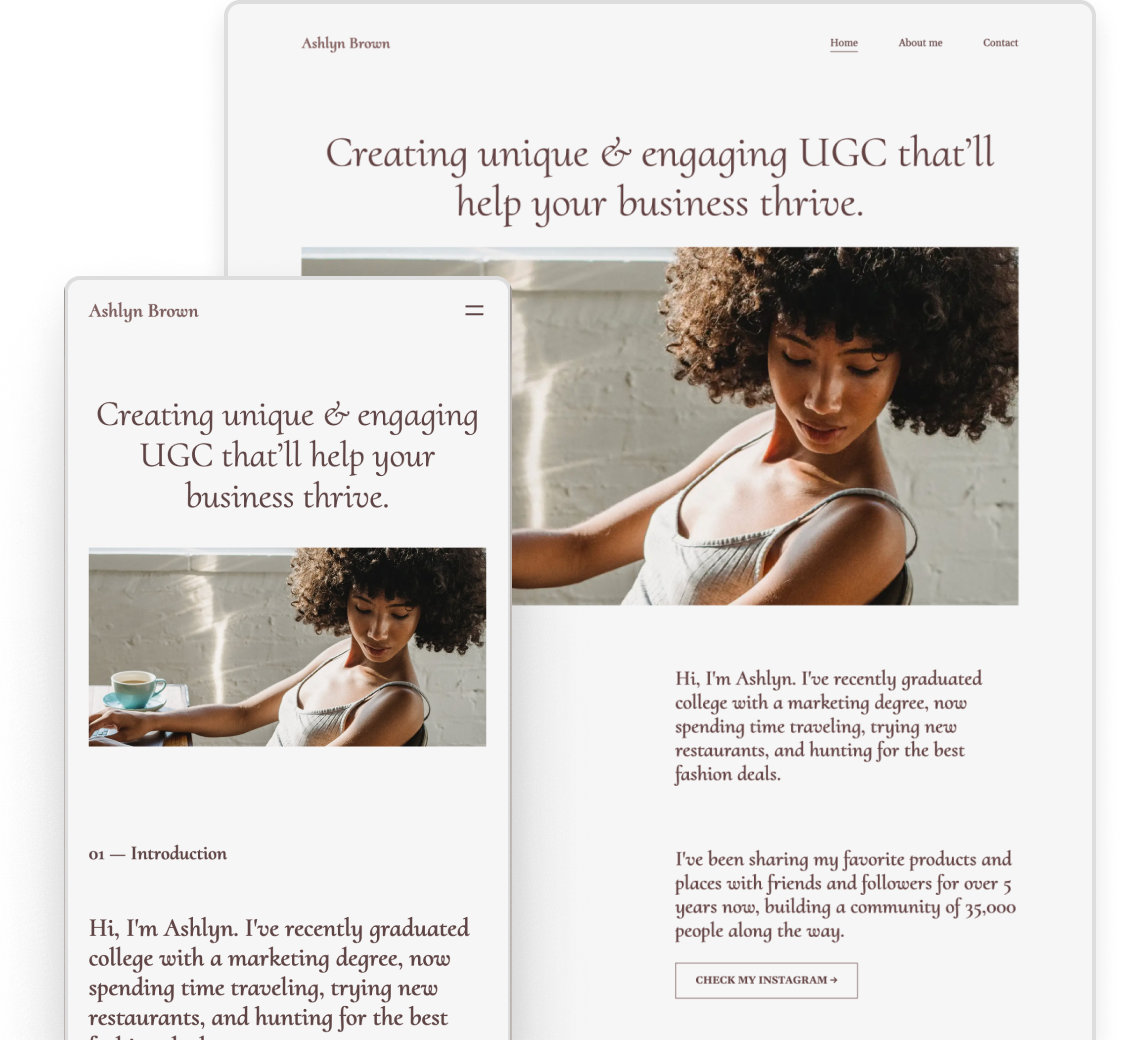13 UGC Portfolio Examples & How to Create Yours Easily
As becoming a UGC creator is getting more popular, you need to make a better impression on brands than ever. A great way to stand out from the crowd is with a professional content creator website —and today we’ll show you how to easily create yours. Complete with impressive UGC portfolio examples, we hope this post will leave you inspired and ready to take action.
13 UGC portfolio examples you need to see
Don't feel like reading? Check 5 of the portfolio examples in this video:
1. Ness Ulanbek
Why we love it: Ness chose beautiful images that go perfectly with the color palette of her site. Having some info about her services at the top is super handy, while the video examples are exactly what a UGC portfolio should be all about.
2. Talasyn Grace
Why we love it: Tala does an even more phenomenal job of showcasing her video content. You can just click to play the clicks right on the page—we love. And if you need more context and samples, you can just click on one of the project thumbnails, easy peasy.
3. Olivia Warren

Why we love it: Olivia's portfolio is just the right amount of everything. A little bit about her, a few of her best samples, and a little education on why UGC can be so beneficial for a business. All that in an aesthetic, easy to read package. Who would say no?
4. Grace Huntington
Why we love it: Gracie went for a super strong first impression. With her signature pink and crystel clear tagline she catches your eyes right away as she leads you to her intro, then samples. Easy to scan and matching her brand character every step of the way.
5. Life with Michelle

Why we love it: you can see the versatility of Michelle's skillset from all the different categories of UGC in her portfolio. We also love how it's super clear how to navigate her site to find what you're looking for, whether it's samples or her current UGC rates.
6. Katie Bright
Why we love it: Katie's portfolio is the perfect example that even hints of a signature color can make a huge difference. Her brand color is definitely purple, and even though her portfolio background is gray, it pops up in the text and the well-coordinated images and UGC video thumbnails. It's subtle yet fun, and always matching her brand identity.
7. Katrina FOREAL

Why we love it: clear mission, check. Location and contact, check. Previous brand collabs for credibility, check. Samples to impress, check. With a portfolio design this nicely structured, there's really not much more we could ask for.
8. Karla Caldwell
Why we love it: a UGC portfolio doesn't need to be just a bunch of videos and an intro. You can get creative with it just like Karla did. She made her portfolio into a blog and incorporated the user-generated content into the articles. Brilliant!
9. Charlene Izere

Why we love it: being a UGC creator basically means running your business and we love seeing that aspect loud and clear on Charlene's page. A lot of creators add a separate page for their services, but here we can see them all right under the first few projects.
10. Alice Blakemore
Why we love it: Alice leads with the most essential info and credentials and backs them up with samples (both UGC videos and pictures) right underneath. It's quick and straight to the point—exactly what busy influencer marketing managers need and have time for.
11. Kellyn Melon

Why we love it: apart from the fun the pink brings to the design, we love the video stats that Kellyn shows right under each piece of content. With that she proves that her content performs without any more clicks needed. Impressive!
12. Jasmine Anderson
Why we love it: niche is important in UGC and we love how Jasmine's content is specialised for moms. It'll make it super easy for brands with the same audience to find her as the perfect fit—and see exactly the kind of content she can create. Plus her rates are easy to find on the homepage, which makes the process even quicker.
13. Katie UGC

Why we love it: samples are cool but reviews take a portfolio to the next level. Because looking at one as a brand, seeing impressive content is cool, but knowing the creator is also a delight to work with? Unbeatable.
What is UGC?
UGC stands for user-generated content, which has become an incredibly popular marketing tool for brands lately. As opposed to ads with paid actors, UGC is created by everyday people, real users, in the form of reviews, photos, or videos.
In these pieces of content, people talk about and review certain products or services, doing it on their own terms, and producing it themselves.
But wait… Isn’t that what influencers are doing? Well, kind of. But not really.
How are UGC creators different from influencers?
While both influencers and UGC creators make content for brands about their products or services, the biggest difference lies in the delivery of the content.
Brands reach out to influencers because of their established following and engaged audience. So when they have a collaboration, the influencer posts the content they created on their own profiles. With that, the brand gets both materials they can repost and extra exposure.
In the case of UGC creators, the brand only gets the content —and posts it on its own profile. While they’re only reaching their own audience, the content can feel more authentic in a world where people are losing trust in influencers.
Can you get paid for UGC?
Yes, you absolutely can!
Thanks to the trend we just mentioned, brands are realizing that working with influencers is not the only way of leveraging online word-of-mouth marketing. So often, especially if they are active on Instagram and TikTok, they’ll reach out to smaller creators to create content for them.
Depending on the quality of the content and how well the creator sells themselves, brands might gift products or outright pay for the images and videos they are sent.
Do UGC creators need portfolios?
The answer is, yet again, yes. If you want to become a UGC creator and earn money with the content you make, you need a portfolio.
As UGC is getting more popular, there will be more and more creators fighting for the attention of brands —so you’ll need a way to stand out. Having a professional portfolio that’s visually appealing and showcases amazing pieces of content you’ve created is a perfect way for that.
It’ll show brands the formats and style of content you’re best at creating and what level of quality they can expect from you. They’ll see if your photos or videos will appeal to their target audience and how experienced or knowledgeable you are in their niche.
How to make a UGC portfolio
Okay, so you need a portfolio if you want to land UGC-creating jobs. But how do you make one with no previous projects to showcase?
The answer is actually pretty simple: you just start creating content about things you already use and add that to your first UGC portfolio. Just because a brand didn’t ask you to make it, a video about a product you know and love will still be UGC. Even better, it will be the most authentic form of it.
So write a list of the products and services that you:
- Use on a regular basis and know really well
- Genuinely enjoy and find helpful
- Align with the things you’d like to help promote
- Think more people should know about
Once you have a list, you can go on to think about creative ways to introduce them (more on that in the next section) and start shooting!
Types of UGC to showcase in your portfolio
There are many different ways to introduce a product or service on the internet. To give you a better idea of your option, we’re going to go through some of these now.
On the higher level, user-generated content can be in the form of reviews, blog posts, images (think Instagram or Pinterest posts), or videos (like TikTok or IG Reels).
When trying to decide what format to go for, check out what your target brands are using and sharing. If their Instagram is full of aesthetic images, consider photography. But if all they post are Reels and they’re huge on TikTok, go for videos.
Currently the most popular and requested UGC format is video, so let’s talk about that in more detail!
Video formats and ideas for UGC
For a little bit of inspiration, here’s a list of video formats creators often use (and viewers like to watch) when it comes to UGC:
- Vlogs and DITL (day in the life)
- Get ready with me and come with me
- Dedicated product features
- Unboxing and first impressions
- Product testing and reviews
- How-tos and tutorials
Of course, for the first two, you’d have to incorporate the products or services as organically and seamlessly as possible. But if you find a way to do so, they’re one of the most entertaining and authentic ones on the list.
Prefer a video format? Watch it below:
How to showcase your content samples
When you have your samples ready comes the question: how do you showcase them in your UGC portfolio?
As you could see from the examples above, there are many ways to do so, but here are the three we recommend:
- Visual + explanation side-by-side
- Gallery of visuals, broken into categories
- Clickable projects in a grid, leading to live posts or case study pages
1. Visual + explanation side-by-side
This is a great approach if you want to showcase a maximum of 5 pieces of content on a page. Any more than that would make your page way too long, but if you can limit the number to 5, it’s an amazing choice.

Why? Because people can easily check the embedded photo or video, while also learning the most important info about it. Things like:
- What brand and target audience did you create it for?
- How did you come up with the concept for it?
- What equipment and software did you use?
- How has it performed if it’s already been posted?
If it has already been posted, you could also add a button to each of these sections that lead to the published version. With that everyone will be able to see how people engaged with it for themselves.
2. A video or image gallery

Have much more content to show? Pop your videos or images into a gallery, so brands can check out each bit easily. In Copyfolio, you can upload your videos, round their corners, add them into mockups, and play around with the play settings too. Add a title and short description for each if you'd like—or let the visuals speak for themselves.
3. Clickable projects in a grid, leading to live posts or case study pages

The third method we recommend is to add clickable thumbnail images in a grid format, where the thumbnail is a preview of the content. The link can then either lead to:
- a new case study page, detailing the questions outlined above and showing more related materials, or
- the post itself if it has been published online by the brand already.
The former lets you communicate more of your process, showing potential clients how it is to be working with you and thus can be more convincing. The latter on the other hand is super quick and can be a great way if you’re short on time.
Not sure how to create pretty thumbnails for them? If you use Copyfolio, you won't even need Canva, just do it all within the app:
What should be included in a UGC portfolio?
We’ve covered the projects, but is that it? Well, not really. If you want a well-rounded UGC portfolio that’ll convince brands to hire you, you’ll need a few other little things.
- An eye-catching homepage and compelling tagline. First impressions are not only important offline. When someone lands on your portfolio, you need to grab and hold their attention —and that’s what your homepage and tagline are for.
- A fun and interesting about page. When you’re about to promote their products, brands not only care about the content you create, but about you as a person too. So show off your personal brand and what a great brand fit you are!
- Your contact information. It’s a little thing, but it’s almost as important as your UGC samples. Because if your contact info is missing, no matter how much they love your content, brands won’t be able to get in touch to hire you.
- And optionally, your prices. For other professions, like copywriting or freelance marketing, people often opt not to share their prices publicly right away. But for UGC creators, it seems to be a common practice, so consider showcasing them as well.
Having stunning images and videos that all match your brand is a great first step. But your tone of voice and personality need to follow suit too, otherwise nobody will take you seriously.
Not sure how to figure it all out? Sign up and take Copyfolio's free brand character quizzeses and find what makes you unique ✨
How to create a portfolio website easily
With all your copy and visuals ready to go, the only thing left to do is actually create your UGC portfolio website. Don’t worry, with a tool like Copyfolio, it’s going to be super easy. It's the best option for UGC creators.
Create an account and choose your template
First, you’ll have to sign up (with your email, Google, or Facebook account) and choose your website template. At this step, you can choose your profession and goal for your website to get customized content added to your site right from the get-go.
Fine-tune your homepage and design
When you land in the editor, to make the process faster, your homepage will already have some pre-filled sections for you. Start with adjusting the text as needed and adding a few personal touches.
You can also customize the design if you want at this point: choose a font pair preset you love and add create your custom color palette to make your site on-brand.
Add your UGC samples
Copyfolio has a section type called Portfolio grid, which is the easiest way to showcase your projects. You can add case study pages if you want to write more about each or choose link-type projects to link to published posts.
In the section settings, you can set the aspect ratios for the thumbnail images. They’re square by default, but you can use portrait or original for phone screenshots. You can also turn project descriptions on or off here —they can come in handy if you opt to just add links.
Have some super aesthetic videos? Don't forget to also add a video gallery to show them off. Is your Instagram feed unbeatable? You can also embed it beautifully to your page for even more rizz.
Add all the extras
With your homepage and projects done, it’s time to add all the extras like your about me and potentially a services or pricing page. Highlight your USP (aka what makes you unique) on either of these page. Alternatively, if you prefer to have a one-pager site, you can also just create dedicated sections for them on your homepage.
Get your custom domain
And if you want to be really professional, you also need to get a custom domain. It could be just yourname.com or if that’s taken already, you can add UGC to it as well. In Copyfolio, you can buy your domain name with one click and it’ll automatically get connected to your site within minutes.
You can get started and try out all the features for free on Copyfolio —then upgrade to Premium for as little as $9/month (when billed yearly) for the extra features like custom colors, multiple projects, or connecting a domain name.












